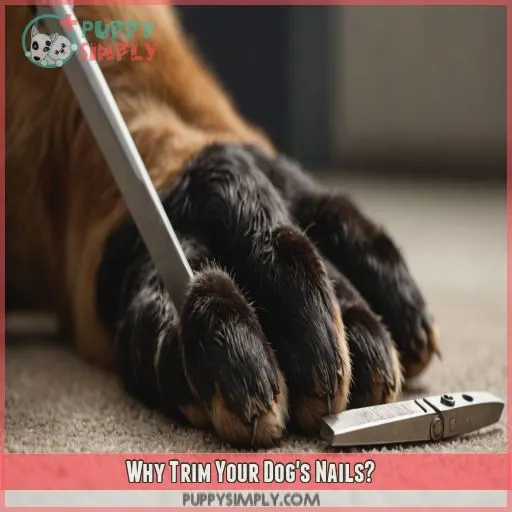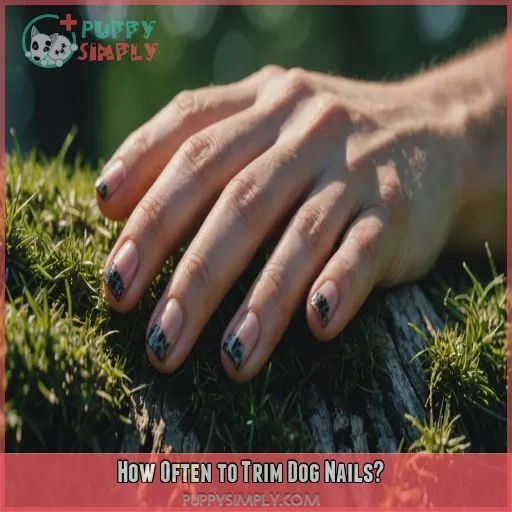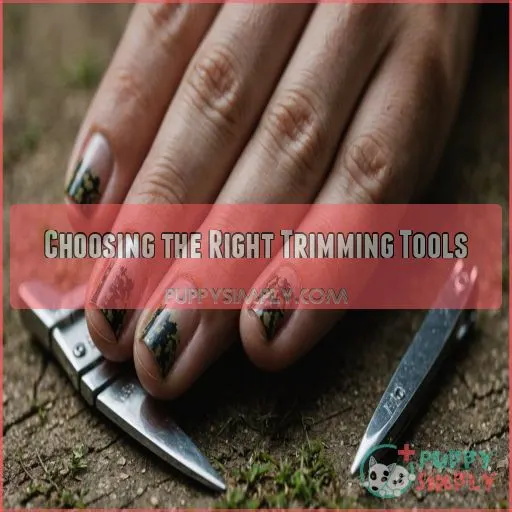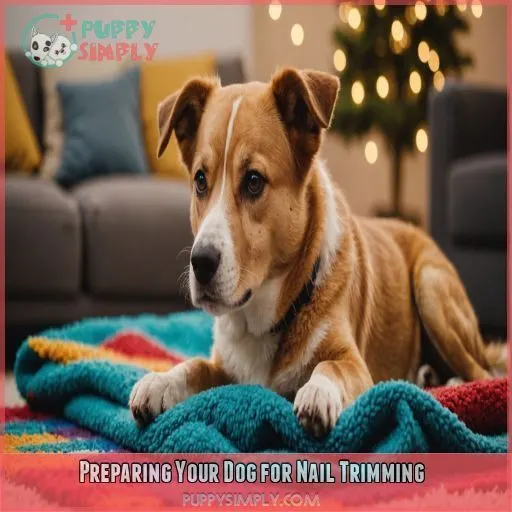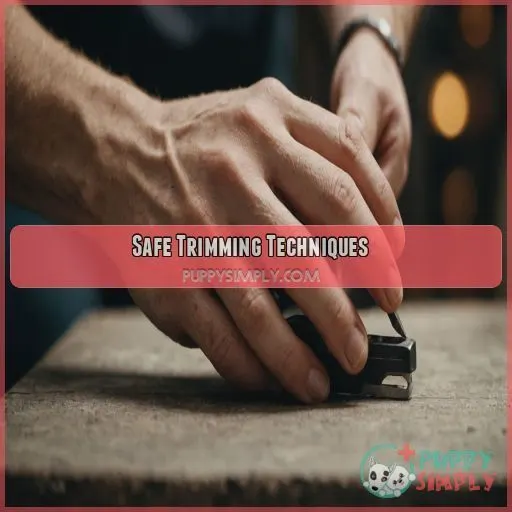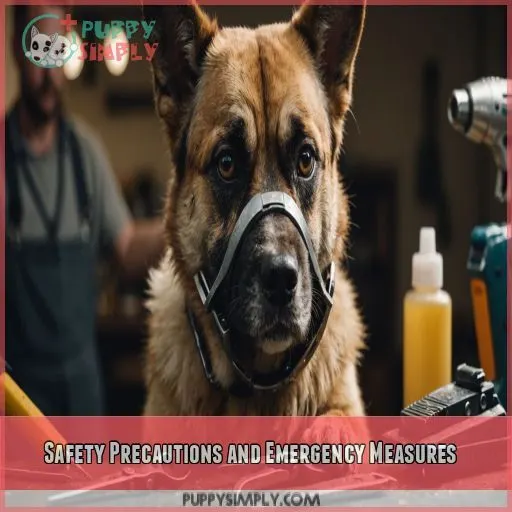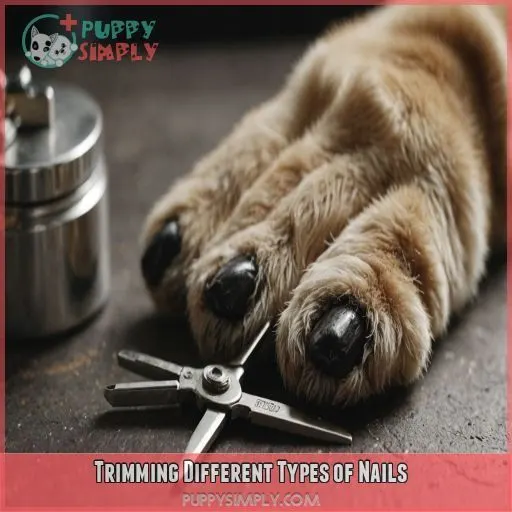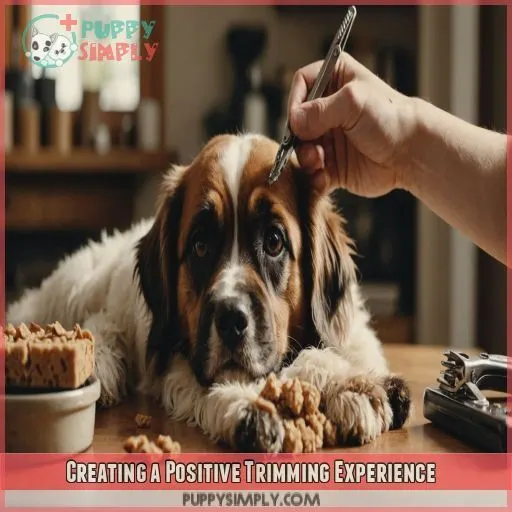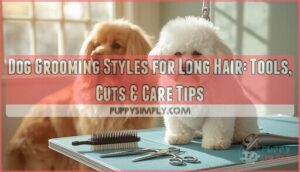This site is supported by our readers. We may earn a commission, at no cost to you, if you purchase through links.
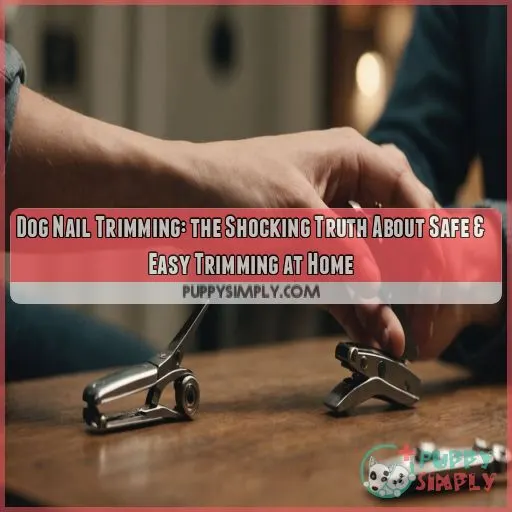
But don’t worry, with the right techniques, you’ll be a pro in no time.
To trim your dog’s nails safely, you’ll want to use clippers or grinders specifically designed for dogs.
Choose the right size for your furry friend’s nail.
Trim just the tip, following the natural curve, and avoid cutting the quick (the pink part that’s basically a doggy nerve center).
For dark nails, trim just the very tip to be safe.
Ready to give it a try?
With practice, you’ll master dog nail trimming: how to do it safely!
Table Of Contents
- Key Takeaways
- Why Trim Your Dog’s Nails?
- How Often to Trim Dog Nails?
- Choosing the Right Trimming Tools
- Preparing Your Dog for Nail Trimming
- Safe Trimming Techniques
- Safety Precautions and Emergency Measures
- Trimming Different Types of Nails
- Creating a Positive Trimming Experience
- When to Seek Professional Help
- Frequently Asked Questions (FAQs)
- How do I secure my dog’s nail trim?
- How do you cut a dog’s nails for beginners?
- What is the most gentle way to trim a dog’s nails?
- What not to do when cutting dogs nails?
- What is the ideal age to start trimming puppy nails?
- Can I use human nail clippers for my dog?
- How do I identify the quick in my dogs nails?
- Can I trim my dogs nails if they have a health condition?
- How do I care for my dogs nails after trimming?
- Conclusion
Key Takeaways
- Don’t sweat it if you’re new to dog nail trimming – with practice, you’ll be a pro in no time! To trim your dog’s nails safely, use clippers or grinders specifically designed for dogs, and choose the right size for your furry friend’s nail. Trim just the tip, following the natural curve, and avoid cutting the quick (the pink part that’s basically a dog’s nerve center).
- You’re probably wondering why trimming your dog’s nails is such a big deal. Well, let’s get real – it’s crucial for their joint health and comfort! Long nails can put pressure on their paws and joints, leading to pain and potentially even arthritis. So, keep those clippers handy to keep your pup happy!
- Trimming your dog’s nails regularly can prevent pain in their paws and joints, promote healthy foot development, and even improve their traction and mobility. As a general rule, most dogs need their nails trimmed every 1-4 weeks. However, remember that your dog’s nail growth rate is unique, so observe and adjust your trimming routine accordingly.
- To avoid the quick and bleeding, gently trim just the tip of the nail, straight across. Keep styptic powder handy in case of an accidental cut, and don’t hesitate to seek professional help if you’re still anxious about trimming your dog’s nails. With the right tools and a little practice, you’ll be clipping like a pro in no time, saving your dog from the pain and discomfort of overgrown nails.
Why Trim Your Dog’s Nails?
You’re probably wondering why trimming your dog’s nails is such a big deal. Trimming your dog’s nails regularly can prevent pain in their paws and joints, promote healthy foot development, and even improve their traction and mobility – and who doesn’t want their pup to stay happy and agile?
Pain Prevention for Your Dog’s Paws and Joints
Trimming your dog’s nails is really important for their joint health and comfort. Long nails can put pressure on their paws and joints, leading to pain and potentially even arthritis, so keep those clippers handy to keep your pup happy!
Foot Health and Preventing Deformed Feet
Now that we’ve covered pain prevention, let’s talk foot health. Long nails can cause your dog’s toes to bend uncomfortably, leading to deformed feet and poor paw health. Regular trimming keeps their foot posture in check, preventing toenail deformities.
Traction and Ease of Walking and Running
Trimming your dog’s nails also improves traction, making it easier for them to walk and run. Here are four reasons why:
- Better grip: Short nails provide a more stable grip on slippery surfaces, reducing the risk of falls.
- Reduced strain: Properly trimmed nails put less strain on joints, supporting dog agility and joint health.
- Paw pad protection: Trimming nails helps prevent overgrowth, which can cause painful paw pad irritation.
- Outdoor safety: Good traction helps your dog run and play safely outdoors.
Clicking Sounds and Their Significance
As you walk your furry friend, do you hear clicking sounds? It’s a clear sign their nails need trimming! Ignoring this can lead to discomfort, pain, and long-term paw damage.
| Nail Length | Floor Type | Paw Health Impact |
|---|---|---|
| Short | Hardwood, Tile | Low Risk |
| Medium | Carpet, Rug | Moderate Risk |
| Long | Hardwood, Tile | High Risk |
| Uncut | Any | Severe Pain |
How Often to Trim Dog Nails?
Trimming your dog’s nails regularly is really important to prevent overgrowth.
Overgrown nails can cause discomfort and health issues.
The frequency of trimming depends on your dog’s individual growth rate.
As a general rule, most dogs need their nails trimmed every 1-4 weeks.
If you’re hearing that telltale clicking sound on the floor, it’s probably time for a trim!
Individual Growth Rates and Needs
Your dog’s nail growth rate is unique, influenced by breed, diet, age, and individual factors. Observe and adjust your trimming routine accordingly, as what works for one pup may not work for another – even within the same household!
General Guidelines for Nail Trimming Frequency
Typically, dogs need nail trims every 1-2 weeks, but this can vary depending on breed, lifestyle, age, and individual growth rates. For example, puppies and active dogs may need more frequent trims, while seniors may require less often.
Checking for Clicking Sounds
To determine if your dog needs a trim, listen for clicking sounds on hard floor surfaces. This indicates their nails are too long. Here are signs to look out for:
- Clicking or tapping sounds on floors
- Visible wear on furniture or carpets
- Changes in your dog’s gait or behavior
Shortening the Quick Over Time
As you check for clicking sounds, remember that regular trims can help shorten the quick over time. This means less stress for you and your dog during nail trimming sessions. Here’s a rough guide to get you started:
| Dog Breed | Nail Growth Rate | Trimming Frequency |
|---|---|---|
| Small breeds | Fast | Every 4-6 weeks |
| Medium breeds | Medium | Every 6-8 weeks |
| Large breeds | Slow | Every 8-10 weeks |
| Active breeds | Fast | Every 4-6 weeks |
| Senior dogs | Slow | Every 10-12 weeks |
Consistent trims will help you find the sweet spot for your dog’s nail growth.
Choosing the Right Trimming Tools
As you get ready to trim your dog’s nails, you need to choose the right tools for the job – and that means selecting clippers or grinders specifically designed for dogs. With the right trimmer and some styptic powder on hand for emergencies, you’ll be well-equipped to give your furry friend a safe and comfortable nail-trimming experience.
Clippers or Grinders Specifically Designed for Dogs
- Trimmer type: Clipper or grinder? Both have pros and cons. Clippers are quick, while grinders are gentler.
- Trimmer size: Choose a trimmer that fits your dog’s nail size.
- Safety features: Look for trimmers with built-in safety stops.
Styptic Powder for Emergency Situations
When trimming your dog’s nails, accidents can happen. That’s where styptic powder comes in – a lifesaver for minor cuts. This miracle powder stops bleeding in its tracks. To use it safely, apply a small amount to the nail with a cotton swab, and gently press for a few seconds.
Features to Consider When Selecting a Trimmer
When choosing a trimmer, consider blade size, grip comfort, and safety features. Look for high-quality materials and reputable brands. Think about your dog’s specific needs – do they’ve thick or hard nails? Don’t be afraid to ask for recommendations from dog nail trimming professionals or specialists for personalized advice.
Preparing Your Dog for Nail Trimming
You’re about to learn the secrets to stress-free nail trimming – and it all starts with preparing your furry friend for this essential grooming task. By starting early, using positive reinforcement, and getting your dog comfortable with the trimmer, you’ll be well on your way to making nail trimming a breeze for both you and your pup.
Starting Early and Gradual Introduction
Now that you’ve got the right tools, let’s get your puppy comfortable with nail trimming. Start early, ideally from 8-10 weeks old. Begin with gentle, positive touch, and let them sniff the clippers. Gradually introduce the clippers to their paws, making it a calm experience. This sets the stage for stress-free trims.
Positive Reinforcement With Treats and Praise
Trimming your dog’s nails can be a bit of a challenge, but positive reinforcement is key. Reward your dog with treats and praise to create a positive association. This approach helps build trust and makes the experience enjoyable for both of you. By rewarding good behavior, you’ll set the stage for stress-free nail trimming sessions.
Getting Your Dog Comfortable With the Trimmer
Here’s the thing: getting your dog comfy with the trimmer is key. Start with positive associations – let them sniff and explore the trimmer at their own pace. Gradually introduce the sound, beginning with low volumes. Desensitization is your friend here. A slow approach will make dog nail trimming a breeze.
Safe Trimming Techniques
Now that you’ve prepared your dog for nail trimming, it’s time to learn the safe trimming techniques that’ll make the process a breeze for both you and your furry friend. With the right tools and a little practice, you’ll be clipping like a pro in no time, saving your dog from the pain and discomfort of overgrown nails.
Proper Grip and Paw Positioning
Now that your dog is comfortable with the trimmer, let’s talk grip and positioning. To safely trim, follow these steps:
- Place your thumb on the pad: gently support your dog’s paw for stability.
- Position your forefinger on top: guide your dog’s toe for precise control.
- Apply gentle finger pressure: secure your dog’s paw without causing discomfort.
- Support the dew claw: be cautious when handling this sensitive area to avoid causing pain.
Clipping Only the Tip of the Nail
Now that you’ve got a good grip on your dog’s paw, it’s time to clip. Trim just the tip, taking care not to cut too short. The ideal nail length varies, but a general rule is to clip straight across, following the natural curve.
Avoiding the Quick and Its Dangers
When trimming, your goal is to avoid the quick, the pink part of the nail containing nerves and blood vessels. Cutting it can be painful for your dog and cause bleeding, so it’s really important to be cautious and prepared.
Grinding and Smoothing Rough Edges
Now that you’ve avoided the quick, it’s time to smooth out those rough edges. Here are three ways to do it:
- Nail grinder: Use a dog-specific grinder to gently wear down the edges.
- Nail file: A dog nail file or emery board can help smooth out ridges.
- Reward calm behavior: Treat your dog for remaining calm during the process.
Safety Precautions and Emergency Measures
As you take on the task of trimming your dog’s nails, you need to be aware of the potential risks and have a plan in place for emergencies. By knowing how to avoid the quick, handle black nails, and use styptic powder, you’ll be better equipped to keep your furry friend safe and stress-free during nail trimming sessions.
Avoiding the Quick and Bleeding
To avoid the quick and bleeding, gently trim just the tip of the nail, straight across. Keep styptic powder handy in case of an accidental cut. Be cautious not to cut past the curve of the nail.
Black Nails and Finding the Quick
Trimming black nails can be nerve-wracking, but don’t worry! To find the quick, look for a chalk-like white ring around it. Use a flashlight or lamp to illuminate the nail, making it easier to spot and avoid the quick.
Using Styptic Powder for Emergencies
Don’t panic if you accidentally cut the quick – styptic powder is your best friend! This miracle powder stops bleeding and promotes clotting. Here’s how to use it:
- Apply a small amount to the nail with a cotton swab
- Gently press the swab against the nail for a few seconds
- Repeat if bleeding doesn’t stop after a minute
Seeking Professional Help When Needed
If you’re still anxious about trimming your dog’s nails, don’t hesitate to seek professional help from a veterinarian or groomer. They can provide guidance, recommend the best trimming schedule for your dog’s breed, and help you master the technique.
Trimming Different Types of Nails
As you get more comfortable with nail trimming, you’ll encounter different types of nails that require special care – think dew claws, black nails, and thick or hard nails. In this section, we’ll walk you through the unique challenges of each and provide you with the know-how to tackle them with confidence and keep your furry friend safe and comfortable.
Clipping Dew Claws Safely
Clipping dew claws safely requires attention to their unique anatomy. Located on the inside of the front legs, these small claws can be tricky to trim. To avoid risks and reap benefits, follow these tips:
- Understand dew claw anatomy: Before trimming, know where the quick starts.
- Use the right tools: Choose clippers specifically designed for dew claws.
- Trim with caution: Cut just the tip, avoiding the quick and painful accidents.
Trimming Black Nails With Caution
Trimming black nails requires extra caution, as it’s harder to spot the quick. Look for a chalk-like white ring around the quick, and trim tiny bits at a time. If you’re still unsure, don’t risk it – seek professional help. Your dog’s safety and comfort are worth it.
Handling Thick or Hard Nails
Thick or hard nails can be a challenge! For dog breeds prone to these, try soaking their nails in water before trimming. Use nail clippers specifically designed for thick nails or consider a grinder for a smoother finish. Be patient and take breaks if needed – it’s all about gentle, gradual progress.
Creating a Positive Trimming Experience
As you prepare to trim your dog’s nails, remember that creating a positive experience is just as important as the trim itself. By building trust and confidence with your dog, making nail trimming a calm experience, and using treats and praise effectively, you’ll set yourself – and your furry friend – up for a lifetime of stress-free nail care.
Building Trust and Confidence With Your Dog
Now that you’ve mastered trimming different types of nails, it’s time to focus on building trust with your dog. Create a positive association by respecting their body language and establishing a consistent routine. Use desensitization techniques and reward-based training to help your dog feel comfortable and confident during nail trimming sessions.
Making Nail Trimming a Calm Experience
As you build trust, focus on creating a calm environment for nail trimming. Handle your dog gently, avoiding sudden movements. Use soothing tones and maintain a relaxed demeanor. Desensitize your dog to clippers and grinders through gradual exposure. This helps create positive associations and reduces anxiety, making nail trimming a breeze.
Using Treats and Praise Effectively
You’re just a treat away from a stress-free nail trimming session! Time treats perfectly by rewarding your dog the moment they remain calm. Create a positive association by using praise variations, like "Good job!" or "Well done!" Consider treat alternatives like playtime or affection for a fun twist.
When to Seek Professional Help
If you’re feeling uncertain or anxious about trimming your dog’s nails, or if you’re having trouble getting the job done, it’s time to seek help from a professional. A veterinarian or experienced groomer can provide guidance, training, and regular maintenance to keep your furry friend’s nails healthy and happy.
Uncertainty or Anxiety About Trimming
Feeling uncertain or anxious about trimming your dog’s nails? Don’t worry, it’s normal! If you’re new to nail trimming or fear cutting the quick, consider consulting a professional groomer or veterinarian for guidance and reassurance.
Difficulty With Nail Trimming
If you’re having trouble trimming your dog’s nails, don’t stress! It’s normal to struggle. Consider seeking professional help from a veterinarian or groomer, especially if your pup shows signs of extreme fear or anxiety.
Need for Guidance or Training
If you’re struggling to trim your dog’s nails or need personalized guidance, consider consulting a professional dog groomer or taking training classes. You can also supplement with online tutorials, vet advice, and DIY tips to master the skill.
Regular Maintenance and Check-ups
Now that you’ve mastered nail trimming, schedule regular maintenance into your grooming routine. Keep an eye on nail growth and adjust your trimming schedule accordingly. Regular vet check-ups will also help make sure your furry friend’s overall paw care is on track.
Frequently Asked Questions (FAQs)
How do I secure my dog’s nail trim?
The ultimate test of trust: holding your dog’s paws without getting squirmed away! Secure their nail trim by gently gripping their paw with your thumb on the pad and forefinger on top of the toe, easy does it.
How do you cut a dog’s nails for beginners?
Cutting your dog’s nails can be intimidating, but don’t worry, you’ve got this! Start by gently touching the clippers to their paw, then gradually work up to trimming just the tip, straight across, while rewarding with treats and praise.
What is the most gentle way to trim a dog’s nails?
Trimming your dog’s nails – the ultimate test of trust and patience! Start by gently touching the clippers to their paw, then gradually work up to trimming, rewarding calm behavior with treats and praise.
What not to do when cutting dogs nails?
When cutting your dog’s nails, don’t cut past the curve, as this can hit the quick and cause pain and bleeding. Also, avoid cutting too short, and never use human nail clippers or trimmers on your pup.
What is the ideal age to start trimming puppy nails?
Get your puppy used to nail trimming from a young age – ideally from 8-10 weeks old. Start with gentle touches and gradual exposure to clippers, making it a positive experience with treats and praise.
Can I use human nail clippers for my dog?
Did you know 75% of dogs show signs of nail-related issues? Don’t risk it! Using human nail clippers on your dog can be hazardous. Instead, choose clippers or grinders specifically designed for dogs to make sure you trim their nails safely and effectively.
How do I identify the quick in my dogs nails?
Locating the quick can be tricky, but don’t worry, you’ve got this! For nails with a clear color, look for a pinkish tint. For darker nails, search for a chalk-like white ring – that’s your cue to stop trimming.
Can I trim my dogs nails if they have a health condition?
If your dog has a health condition, chat with your vet about how often to trim their nails. It depends on the condition and their paw health. In general, nail trimming is safe for dogs with health issues, but your vet can advise on frequency and technique.
How do I care for my dogs nails after trimming?
After trimming, gently massage your dog’s paws with a soothing balm or oil to calm them. Monitor for signs of irritation or bleeding, and reward their bravery with treats and affection – they’ve earned it!
Conclusion
Now that the "paws-itive" truth is out, it’s time to take the leap!
As you master dog nail trimming, you’ll be saving your furry friend from potential pain and discomfort.
How to do it safely:
With the right techniques and tools, you’ll be clipping like a pro in no time.

